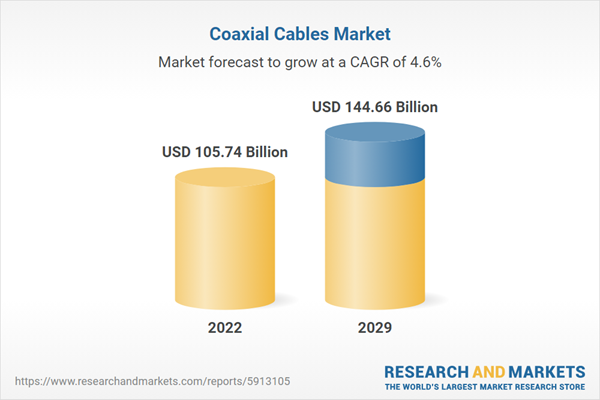Coaxial Cables Market is expected to grow at a CAGR of 4.58% from a market size of US$105.74 billion in 2022 to reach US$144.66 billion in 2029.
Coaxial cable stands out as an electrical cable distinguished by its structure comprising an inner conductor, a concentric conducting shield, and a dielectric material serving as insulation between them. Renowned for their durability and resistance, these cables find extensive applications in broadband internet networking, cable television, telecommunication systems, and video transmission. The burgeoning demand for high-speed data transmission emerges as a pivotal driver propelling the coaxial cable industry’s growth, thereby expanding the overall market size.
A widespread network of existing coaxial cable infrastructure spans the globe, presenting opportunities for various applications and reducing the necessity for extensive and costly new installations in many instances. With a long history of reliable performance, coaxial cables are a well-established technology. They play a vital role in the backhaul networks of cellular communication systems, linking base stations to core networks.
Coaxial cables emerge as a cost-effective solution for ensuring reliable data transmission in environments with minimal electromagnetic interference. Moreover, for transmitting data over shorter distances, coaxial cables offer sufficient bandwidth at a lower cost compared to fiber optics.
Growing economies with evolving infrastructure hold significant potential for the coaxial cable market. In essence, the coaxial cable market underscores the enduring value of established technology in an ever-evolving landscape. Leveraging their cost-effectiveness, existing infrastructure, and versatility, coaxial cables are poised to remain integral in data transmission for years to come.
These qualities render coaxial cables highly suitable for a variety of applications reliant on high-speed data transfer, including cable television networks, broadband internet connections, and video surveillance systems. Notably, fixed broadband subscriptions continue to witness growth across nearly all OECD countries, totaling 481.6 million as of December 2022, with an average of 35 subscriptions per 100 inhabitants.
Fiber optic cables, known for their superior data transmission speeds and minimal signal loss compared to coaxial cables, are gaining traction. As fiber optic technology becomes more cost-effective and accessible, it has the potential to supplant coaxial cables in specific applications.
Formable coaxial cables are flexible and adaptable, catering to applications that require some degree of bending or movement, such as subscriber connections in CATV networks, Wi-Fi antenna connections, and in-building Distributed Antenna Systems (DAS).
Twin-axial cables find niche applications in balanced signal transmission for differential signaling circuits and certain data communication systems. Triaxial cables are utilized in applications demanding very high levels of signal protection. Other types include semi-rigid coaxial cables, low-loss coaxial cables, and plenum cables.
Recent statistics from the Ministry of Industry and Information Technology (MIIT) of China reveal that the number of connections for cellular Internet of Things (IoT) services reached 1.84 billion in China by the end of 2022, marking a significant increase of 447 million from the previous year. This figure represents approximately 70 percent of the world's total, underscoring the region's dominance in IoT adoption and its impact on the demand for coaxial cables.
Coaxial cable stands out as an electrical cable distinguished by its structure comprising an inner conductor, a concentric conducting shield, and a dielectric material serving as insulation between them. Renowned for their durability and resistance, these cables find extensive applications in broadband internet networking, cable television, telecommunication systems, and video transmission. The burgeoning demand for high-speed data transmission emerges as a pivotal driver propelling the coaxial cable industry’s growth, thereby expanding the overall market size.
A widespread network of existing coaxial cable infrastructure spans the globe, presenting opportunities for various applications and reducing the necessity for extensive and costly new installations in many instances. With a long history of reliable performance, coaxial cables are a well-established technology. They play a vital role in the backhaul networks of cellular communication systems, linking base stations to core networks.
Coaxial cables emerge as a cost-effective solution for ensuring reliable data transmission in environments with minimal electromagnetic interference. Moreover, for transmitting data over shorter distances, coaxial cables offer sufficient bandwidth at a lower cost compared to fiber optics.
Growing economies with evolving infrastructure hold significant potential for the coaxial cable market. In essence, the coaxial cable market underscores the enduring value of established technology in an ever-evolving landscape. Leveraging their cost-effectiveness, existing infrastructure, and versatility, coaxial cables are poised to remain integral in data transmission for years to come.
Market Drivers:
High demand for data transmission bolsters coaxial cables market growth:
The surge in digital content accessibility, alongside the widespread embrace of high-definition video streaming platforms, has sparked significant demand for efficient and reliable data transmission methods. Coaxial cables have emerged as a prime solution to meet this demand, thanks to their impressive attributes, such as high bandwidth capacity and minimal signal degradation.These qualities render coaxial cables highly suitable for a variety of applications reliant on high-speed data transfer, including cable television networks, broadband internet connections, and video surveillance systems. Notably, fixed broadband subscriptions continue to witness growth across nearly all OECD countries, totaling 481.6 million as of December 2022, with an average of 35 subscriptions per 100 inhabitants.
Telecom industry expansion drives the coaxial cable industry growth.
As telecom networks expand to accommodate growing internet penetration and the implementation of advanced communication technologies like 5G, coaxial cables play a vital role in ensuring reliable and high-speed transmission of voice, data, and video signals. This heightened demand for coaxial cables as a connectivity solution is driven by the continuous expansion of the telecom industry. Government sources indicate that the telecom sector in India ranks as the fourth-largest in terms of foreign direct investment (FDI) inflows, contributing 6% of the total FDI inflow. Moreover, it directly employs 2.2 million individuals and indirectly supports 1.8 million jobs.Market Restraint:
Technological replacements
Advancements in technology, such as the rise of wireless technologies and the increasing prevalence of Wi-Fi and 5G, offer alternative methods for data transmission, particularly in home and office settings.Fiber optic cables, known for their superior data transmission speeds and minimal signal loss compared to coaxial cables, are gaining traction. As fiber optic technology becomes more cost-effective and accessible, it has the potential to supplant coaxial cables in specific applications.
Coaxial cables market segmentation by type hardline coaxial cables, formable coaxial cables, twin axial cables, triaxial cables, and others
The coaxial cables market is segmented by type into hard-line coaxial cables, formable coaxial cables, twin axial cables, triaxial cables, and others. Hard-line coaxial cables excel in long-distance signal transmission owing to their minimal signal loss, making them suitable for applications like cable television (CATV) networks, high-speed internet connections, and satellite communicationsFormable coaxial cables are flexible and adaptable, catering to applications that require some degree of bending or movement, such as subscriber connections in CATV networks, Wi-Fi antenna connections, and in-building Distributed Antenna Systems (DAS).
Twin-axial cables find niche applications in balanced signal transmission for differential signaling circuits and certain data communication systems. Triaxial cables are utilized in applications demanding very high levels of signal protection. Other types include semi-rigid coaxial cables, low-loss coaxial cables, and plenum cables.
APAC is anticipated to hold a significant share of the Coaxial cable market.
The Asia-Pacific region commands a substantial portion of the coaxial cable market, propelled by infrastructure advancements, a flourishing telecom industry, and heightened demand for efficient data transmission, particularly in the big data sector.Recent statistics from the Ministry of Industry and Information Technology (MIIT) of China reveal that the number of connections for cellular Internet of Things (IoT) services reached 1.84 billion in China by the end of 2022, marking a significant increase of 447 million from the previous year. This figure represents approximately 70 percent of the world's total, underscoring the region's dominance in IoT adoption and its impact on the demand for coaxial cables.
Market Developments:
- June 2023- Tropical Cable & Conductor Limited (TCCL), a prominent manufacturer of electrical cables and conductors, recently unveiled its latest product, the Coaxial TV Cable. This particular type of communication cable is crafted with a pure copper core, ensuring optimal signal conductivity. The Coaxial TV Cable is primarily designed for connecting satellite antennas, TV antennas, and CCTV cameras to television sets. It finds applications in various facilities, homes, and businesses where reliable signal strength is crucial for high-quality audio and video transmission.
- March 2023- Times Microwave Systems introduced the XtendedFlex 178 continuous flex coaxial cable, which is designed to provide exceptional bend movement and consistent electrical performance even during continuous flexure. It incorporates a FEB dielectric, tin-plated copper braid for shielding, and a durable rubber jacket for added protection. By combining such elements, the XtendedFlex 178 cable offers both flexibility and durability, enabling it to withstand the demanding conditions of millions of flexures.
- November 2022- Infinite Electronics Inc. acquired the Cable Connectivity Group (CCG) from Torqx Capital Partners and TKH Group NV. This strategic move bolsters Infinite Electronics' brand portfolio, enabling the company to significantly enhance its presence in Europe while better aligning itself with customer requirements for cutting-edge cable connectivity solutions.
Market Segmentation:
By Type
- Hard-Line Coaxial Cables
- Formable Coaxial Cables
- Twinaxial Cables
- Triaxial Cables
- Others
By Component
- Core
- Dielectric
- Wire Mesh
- Deck
By Application
- Broadband Internet Networking Cables
- Cable Television
- Telecommunication System
- Video Transmission
- Others
By Geography
- North America
- USA
- Canada
- Mexico
- South America
- Brazil
- Argentina
- Others
- Europe
- Germany
- France
- UK
- Spain
- Others
- Middle East and Africa
- Saudi Arabia
- UAE
- Others
- Asia Pacific
- China
- Japan
- India
- South Korea
- Australia
- Others
Table of Contents
1. INTRODUCTION
2. RESEARCH METHODOLOGY
3. EXECUTIVE SUMMARY
4. MARKET DYNAMICS
5. COAXIAL CABLES MARKET BY TYPE
6. COAXIAL CABLES MARKET BY COMPONENT
7. COAXIAL CABLES MARKET BY APPLICATION
8. COAXIAL CABLES MARKET BY GEOGRAPHY
9. COMPETITIVE ENVIRONMENT AND ANALYSIS
10. COMPANY PROFILES
Companies Mentioned
- Galaxy Wire & Cable, Inc.
- Belden Inc.
- Siemens AG
- Amphenol Broadband Solutions (Amphenol Corporation)
- LS Cable & System
- TE Connectivity
- Prysmian Group
- Alpha Wire
- Relemac Technologies Pvt. Ltd.
- Jiangsu Elesun Cable Co.,Ltd.
Methodology

LOADING...
Table Information
| Report Attribute | Details |
|---|---|
| No. of Pages | 141 |
| Published | March 2024 |
| Forecast Period | 2022 - 2029 |
| Estimated Market Value ( USD | $ 105.74 Billion |
| Forecasted Market Value ( USD | $ 144.66 Billion |
| Compound Annual Growth Rate | 4.5% |
| Regions Covered | Global |
| No. of Companies Mentioned | 10 |









